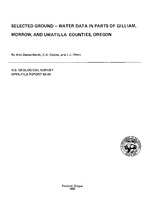Over the last 20 years there has been a shift from dryland to irrigated agriculture in parts of Gilliam, Morrow, and Umatilla Counties in northeastern Oregon. Some irrigation water used in this area obtained from surface sources, but a significant amount is obtained from wells. The principal aquifer in the area is the Columbia River Basalt Group. Wells in the basalt are commonly drilled to depths of 500 to 1,200 ft and many produce more than 1,000 gal/min. A cooperative ground-water modeling study by the U.S. Geological Survey and Oregon Water Resources Department has resulted in the compilation of data from drillers logs and well inspections for wells completed in the basalt aquifer. Water-level measurements have been made in some wells in the area since the 1950's. The wells with longest periods of record are those that are part of a Statewide network of observation wells measured by the U. S. Geological Survey and Oregon Water Resources Department. This report includes a table of well information, representative hydrographs, and well location maps. (USGS)


